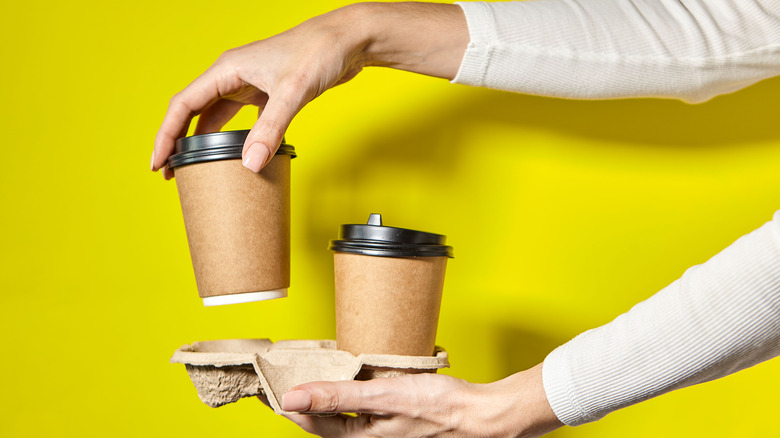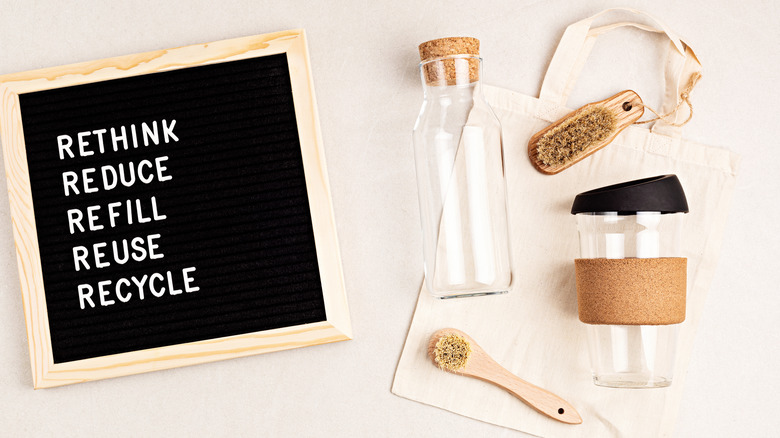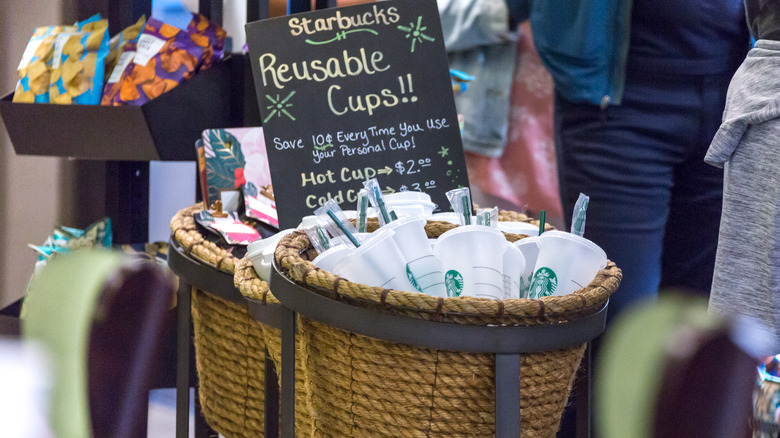The Reason Single-Use Coffee Cups Usually Aren't Recyclable
How many times have we tossed paper coffee cups in recycling bins, assuming our small contribution will inch the world toward sustainability and waste elimination? Paper is recyclable, after all. But there's a bigger story when it comes to cups. Some versions are accepted by about 30 North American paper mills, which turn them into container boards, tissues, and various forms of paper, per the American Forest & Paper Association. The glaring exception is for single-use coffee cups: They usually aren't recyclable at all.
First, let's look at what is recyclable from your morning "cuppa joe" routine. If you grab a hot to-go coffee from a drive-thru or sit-down coffee shop, it likely comes with a paper sleeve to protect your hand from the heat. It's typically recyclable, according to Republic Services. The lid on the coffee cup keeps sloshing to a minimum as you dash to work or school – also recyclable. If you instead order a cold-brew coffee, there's a chance the plastic cold cup fits recycling criteria – but the accompanying plastic straw doesn't pass muster. That's because mechanical sorting equipment at recycling centers cannot process such small, lightweight items, explains Green Matters.
So, why are single-use cups for hot coffee doomed to landfills when other cups get new recycled lives? There's a very simple answer to that and a few evolving solutions.
Plastic, paper, and alternatives
The vast majority of single-use coffee cups fail recycling criteria because the paper cups come "coated with plastic," explains Republic Services. The plastic reinforces the cups to prevent leakage of hot liquids. The combination of paper and plastic in a single cup makes them non-recyclable. Though the amount of plastic per cup could be just 5%, per Recycle Coach, it still typically sends them to landfills.
An obvious solution is to tote a reusable cup on your daily journey, and many options provide ecologically sound alternatives to non-recyclable and non-compostable coffee cups. The editors of Vogue weigh in with favorites in the form of coffee cups, travel mugs, and sleek tumblers touting features such as stainless steel, vacuum insulation, no-slip grips, collapsible construction, and even temperature-controlled "smart mugs." The Sustainable Living Guide points out eco-friendly coffee cup options featuring glass, silicone, cork, or other recycled or discarded materials. Others bypass BPA materials that can be absorbed into liquids, per Toxic-Free Future.
Even so, reusable coffee cups aren't always convenient for many consumers. That could soon change as at least one major coffee chain sets a course correction to eliminate single-use disposable cups and offer "borrowable" reusable ones.
Agents for change
Starbucks, one of the largest global commercial coffee chains, is taking steps in 2022 to eliminate or greatly reduce its dependence on single-use coffee cups, according to CNCB. With at least 32,000 coffee venues worldwide, Starbucks uses about 7 billion disposable cups annually – yes, billion. That's a whole lot of unrecyclable waste stacking up every day. Michael Kobori, the company's chief sustainability officer, revealed that 40% of Starbucks packaging waste comes from disposable cups and lids.
The company has long set goals for reducing that amount but recently announced specific plans for converting to reusable cups, stating a desire for all customers to easily access reusable cups for their Starbucks coffee purchases by 2025. Its Borrow-a-Cup program has already launched at Seattle's SODO-8 café inside company headquarters and similar For-Here-Ware programs are in testing at overseas locations, including South Korea. Customers can also bring their own cups from home, and in-store cup-washing stations will be installed, per Starbucks Stories.
Kobori acknowledges that the Starbucks disposable coffee cup is its primary icon, vowing to replace that "symbol of waste" with reusable options, thereby changing mindsets and fostering industry-wide change. Eliminating single-use coffee cups is part of a larger plan to cut in half the overall waste and carbon emissions from direct operations and supply chains by 2030, leading to a "resource positive" operation, per Starbucks. Whether other coffee shops will follow suit remains to be seen.


